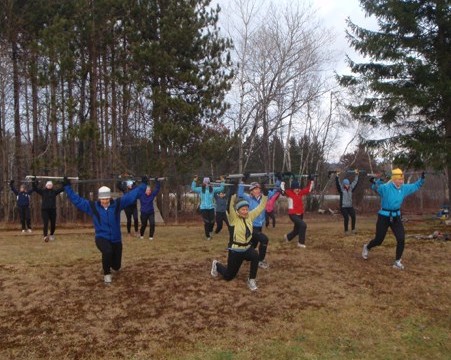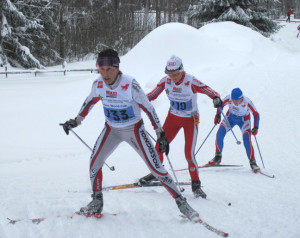
Trina Hosmer believes that dry land training is one of the best things you can do to improve your skills on cross country skis. She should know– she has competed for the last 44 years—first at the Women’s World Champion Cross Country events, then on two Women’s Olympic Cross Country ski teams and now, in the World’s Master’s Competitions. She says she wasn’t very good when she competed at that first Women’s World Champion Cross Country events in 1970 in Czechoslovakia.
- In 2009, 35 years after she competed in the 1974 World Championships in Sweden, she returned there to ski in the Master’s competition. She won 4 medals. “The topography hadn’t changed ( the same steep hills) but if you stay with something long enough and keep working at it your results do,” she says. Some of these improved results she attributes to her dryland training.
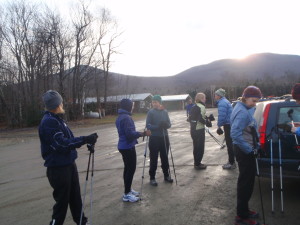
Putting these beliefs into action, Trina is generously helping others improve their skills by leading a Women’s Cross Country Ski group in Stowe, Vermont ,that starts training in October with dry land drills. The group started in 1995 and has grown from 8 women to 50. They range in age from 30s to 60s, and in ability from beginner to racers. The emphasis is on learning to ski more efficiently, whether you want to ski for an hour or race a 50k. The only requirement to join is that you become a member of Stowe Nordic Outing Club (SNOC) and pay a minimal fee.
On the first Friday in October the cars start arriving at the Stowe Mountain Nordic Trails of Stowe Mountain Resort. Women, with their running shoes on and ski poles in hand, greet each other warmly, some having attended all six years. Until they are able to get on snow, they will train each week from 3-4:30 by ski walking and ski bounding–always attempting to imitate correct ski body stance and arm movement.
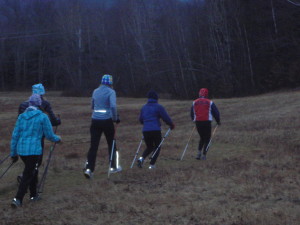
The day’s training starts with the group running a loop around a field to warm up, and then forming a circle to do standing exercises that include swinging the arms (without poles) to get the feeling of where they should be while skiing, and standing on one leg while lifting the other leg behind them in the xc position to improve balance. The training then moves to a demonstration of ski walking and ski bounding . Trina describes the techniques as follows: “The human motion for ski walking is, literally, a walk with ski poles. The walk is exaggerated and each stride is longer than a normal walk. Ski walking can vary from a slow tempo walk to a high tempo walk. As the workout intensity becomes higher, the tempo increases. Ski walking is the easier of the two. Ski bounding is a combination of a skip and run with poles. Imagine yourself with a pair of skis on, running/skipping up a hill with your ski poles. Ski bounding can vary between a powerful bound to a high tempo bound. As skiers become stronger, the bound will become more powerful. In addition the amount of power used will be dependant on the intensity of the workout and the goal of the workout.” We watch and listen, with the group repeating her movements after watching the correct form.
Then it’s Trina’s turn to watch. She focuses on each woman’s arm and body position. “Your arms are flapping.” she says to one of the newcomers. Seeing the woman’s surprised look she follows up more softly with ” No one is exempt from my criticism!” The group laughs in recognition of this truth. Her focus is also on the women’s hips, making sure the drive forward is coming from the rotation of the hips. She can often be heard saying “drive with your hips!” or “dig with those arms!” as the women practice.
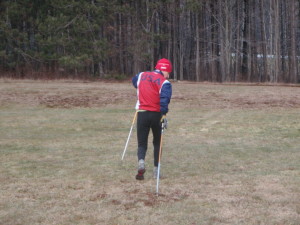
This year, because of the size of the group, Trina has recruited two women who are competitive skiers to help out. At the end of the demonstrations, the group breaks into two, with new members going with Trina and the more advanced skiers teaming up with the two new leaders.
Through the coming weeks, the intensity of the training will increase for everyone. What began on flat ground moves on to hillier terrain and then advances to loops around the Nordic trails. Often, the women go up the same hill many times. There is no rest coming down hill; this is the time for double poling exercises that emphasize core crunching and setting the arms in the ground for power. It is difficult to describe the bounding motion or the double poling exercises without seeing them done. Both take intense cardiovascular effort. When done well, the ski bounding results in being in the air for a good part of the time, almost like floating .
The boredom of weekly routines is broken up with friendly team competitions to see which team will finish first in a drill. Each woman takes her own training seriously but offers non-judgmental encouragement to everyone on her team. It is a time of whooping and hollering and congratulating individual improvements made.
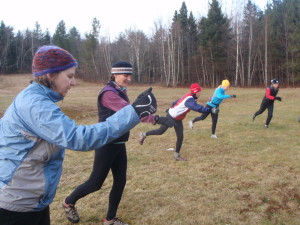
Balance drills are an integral part of the training, too. “You really are not skiing unless you are skiing on one ski, so balance is key,” says Trina. She often states that walking on skis is not skiing. To enhance balance she has the women stand on one leg in the ski position and then hop to the other.
Trina’s love of the sport is always evident and her enthusiasm carries over into the group. Smiles, laughter and good humored complaining are all part of the ambience.
At the end of each day, the two groups meet up, and announcements are made about upcoming ski workshops, waxing clinics and the news from SNOC.
Trina encourages the women to do core exercises or yoga for flexibility, and hike with their poles in between these Friday sessions. Not only does working with poles add an upper body workout to a hike, but it also increases stability and circulation and takes the pressure off your knees. “Women in general do not have much upper body strength,” Trina states. “Hiking with poles really works your arms and your shoulders.” Everyone looks tired but happy as they leave. Once the snow comes, the group will move onto their skis, but for now they are improving both their aerobic capacity and their skills without them.
While you may not have access to a dry land training group, you can greatly improve your skiing before you get on snow. Hike with your poles, strengthen your core with sit ups or planks, do balance exercises in the gym, find a ski instructor who can show you the ski walking and bounding techniques. And have fun while you wait for the snow!
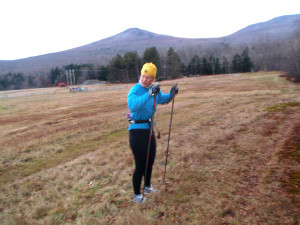
RESOURCES:
Master Skier article on ski bounding
Where They Are Now, Ski Trax interview withTrina
UPCOMING WORKSHOPS AND TRAININGS:
December 11-12, 2010: Introduction to Performance Skiing and Racing at Trapp Family Lodge
January 8, 2011: Catamount Trail Associations Women’s Day Cinic
January 30, 2011: New England Women’s XC Ski Day
Other events throughout the winter: New England Nordic Ski Association


